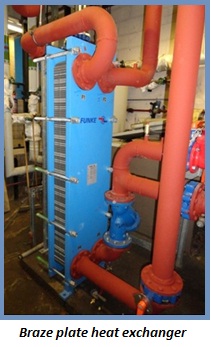
PLATE HEAT EXCHANGERS

Each building in the network will require a heat exchanger to provide an interface between the primary and secondary networks.
Plate heat exchangers (seen to the left) are cheaper and require less space compared with standard shell and tube exchangers. They require significantly less surface area, than shell and tube units because of much higher heat transfer rates. Domestic hot water can be generated, saving the losses with storage and reducing time delay in regeneration.
There are two main types of plate heat exchangers identified as being appropriate, namely the Brazed Plate Heat Exchanger and the Gasket. Brazed plate heat exchangers are sealed units that cannot be disassembled. They are smaller, require less maintenance, and are less expensive. The gasket heat exchanger material however can degrade losing ability to seal resulting in water leaks, and they tend to suffer when the heating is frequently switched on and off. Therefore, the Brazed plate heat exchangers are recommended for this district heating network.
PUMPING REQUIREMENTS

The pumps that would be used in the network are two variable speed pumps. This pump type adapts the flow rate based on demand, and therefore saves cost on electricity. Both pumps would work at part load, so that a backup is available should one fail. They are sized based on the required pumping pressure in the network and the pumping duty. For scenario 1 the pumping duty was 4.8kg/s with a pumping pressure of 3.2 bar, and for scenario 2 the pumping duty was 6.4g/s with a pumping pressure of 4.5 bar.
METERING AND BILLING
An essenstial requirement of any district heating scheme is accurate billing and metering for the customer. It is important that the customer is billed fairly and only for the heat that is taken from the district heating network.
Each building is metered and billed based only on the amount of heat taken directly from district heating network. The energy used is measured by an ultrasonic meter which has no moving parts
The meter measures the flow and temperature in and out of each heat exchanger to compute the heat that is taken out of the system. The customer can read the temperatures, flow rate and heat demand at any given time to assess how much energy they are using.
Typically, the meters are fitted with a radio meter and every quarter a signal is sent out to a central control building to assess how much energy has been used. Through this system accurate bills can be provided to the customer, which is important if the council has future ambitions to extend the network to suit futher private residences.
References:
- Bard Skagestad, Peter Mildenstein. District Heating and Cooling Connection Handbook. Programme of Research, Development and Demonstration on District Heating and Cooling. International Energy Agency.
- GEA Ecoflex. (2006). Plate Heat Exchangers. General operation manual.
- SEC. (2006). Plate Heat Exchangers. General operation manual. Belfast.
- H. Dardour, S. Mazouz, A. Bellagi. (2009). Numerical Analysis of Plate Heat Exchanger. World Academy of Science, Engineering and Technology .